Femia > Health Library > Your cycle > Health > Twin pregnancy belly week by week: What to expect
Twin pregnancy belly week by week: What to expect
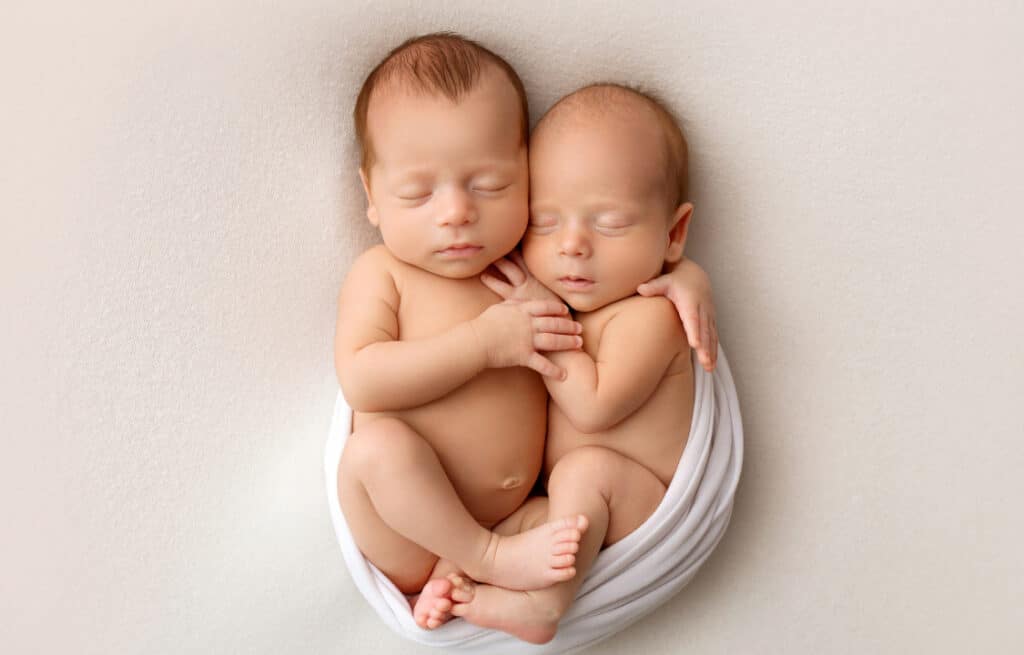
- Updated Feb 25, 2025
- Published
CRAFTED BY HUMAN
Crafted by human At Femia, we provide accurate and up-to-date information at every stage of your journey, from trying to conceive, pregnancy and postnatal support. All content is created by a real person based on in-depth research and own professional experience. Femia ensures that you will receive expert advice, strict accuracy and a personalized approach from our authors/medical experts. Learn more about our editorial policy.
FACT CHECKED
Fact checked At Femia Health, we maintain the highest standards of editorial excellence in delivering content focused on helping you conceive, guiding you through pregnancy, and supporting you postpartum. Explore our content review principles to learn how we ensure the accuracy and quality of our health and lifestyle tips for every stage of your journey.
Twin pregnancy belly often matches the standard growth pattern inherent in a single pregnancy. From the moment of conception (when it’s just a tiny egg), each of your babies can reach the size of a watermelon by week 40 into pregnancy. Still, it’s important to understand that every pregnancy journey can be unique, and the size of a baby bump can be predetermined by a number of factors, including maternal health, genetics, and more.
Being pregnant with twins is a unique journey, with twin births making up only 2% to 4% of all births (and that’s already an increased rate compared to 20–30 years ago). Carrying two of your future babies is double the joy and a very exciting experience. But of course, it might be somewhat different compared to a single-child pregnancy, and you probably want to be prepared for this.
One common concern associated with this unique journey is belly growth and size during pregnancy. Many women who experience this unique situation want to understand their twin pregnancy belly week by week size to know what to prepare for on their path.
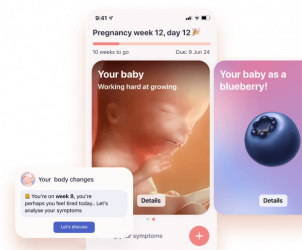
While twin pregnancies often follow a general growth pattern, every pregnancy experience is different. In this guide, we‘ll discuss possible twin pregnancy belly sizes, factors that might influence the size, and tips to embrace the changes in your body.
👉Find out more: First trimester pregnancy diet: 1 to 3-month pregnancy diet chart and meal plans
Twin pregnancy week by week - First trimester (weeks 1–12)
Weeks 1–4: Twins implantation
The first month is when you may just be discovering that you’re pregnant. There might be no visible changes in your body during this period, because the embryos are just starting to develop.
The development process of embryos depends on the type of twins you are having:
- Identical. One sperm fertilizes one egg, and conception happens. A fertilized egg develops into a single cell (zygote) with 46 chromosomes responsible for a child’s sex and physical traits. During the early pregnancy stage, this cell splits and grows into two separate embryos, creating identical twins.
- Fraternal. Two sperm fertilize two eggs and develop into two separate zygotes.
About eight or nine days after fertilization, the tiny balls of cells turn into two blastocysts and implant into the lining of the uterus. Another week later, the blastocysts start forming placentas for each of your twins. Sometimes, both babies may share a single placenta.
After the implantation, the embryos start developing and growing, first, by forming brains and spinal cords.
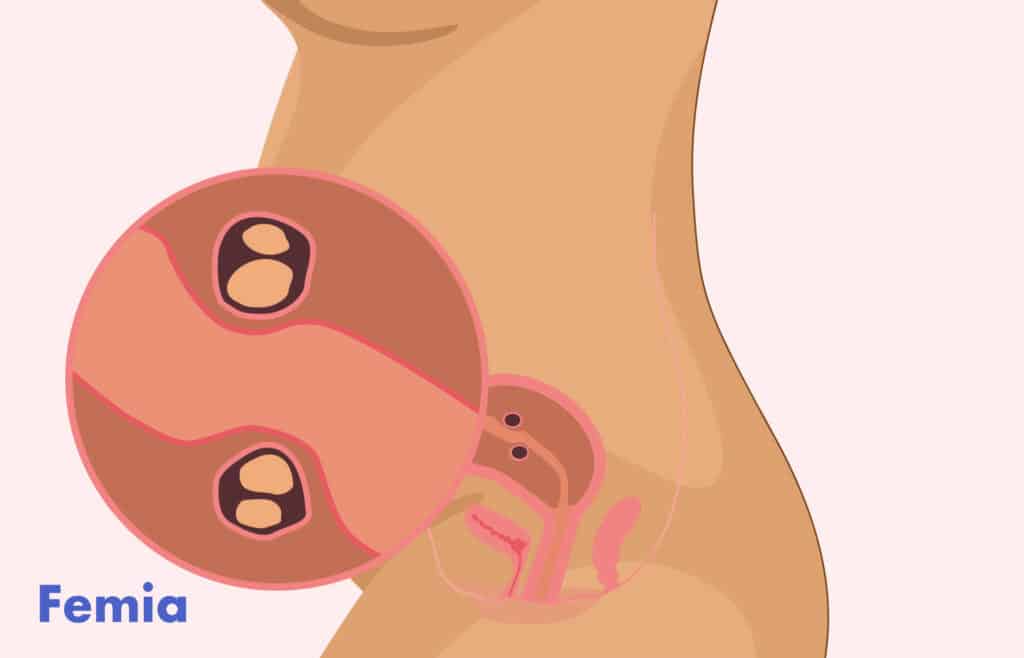
Weeks 4–6: Twins embryos
Somewhere around the end of the 6th week, when your twins have developed spinal cords and brains, they are the size of a sweet pea. By then, some women might be experiencing early pregnancy symptoms like mood swings, breast tenderness, nausea, and the initial expansion of the uterus. The symptoms of a twin pregnancy are typically the same as in a single-embryo pregnancy.
When you are 6 weeks pregnant with twins, it’s already possible to confirm a twin pregnancy with an ultrasound.
👉Find out more: Difference between single and twin pregnancy symptoms

Weeks 7-8 pregnant with twins
In weeks 7–8, the embryos’ cardiac tissue starts to develop. Their faces and inner ears begin to shape. Arms and legs appear in the form of small buds with emerging webbed fingers and toes.
At this stage, you may start noticing the first physical changes in your body:
- Breast tenderness may increase, and breasts generally may get larger
- Nipples may start to stick out more
- Your weight may go a few pounds up or down
- Excess gas and bloating
- Twin pregnancy belly, 8 weeks: you may see the first signs of a baby bump
You might also experience an overactive bladder (aka an increased urge to urinate during the day). This happens due to an increased blood flow needed to fill the large vessels of the uterus, which has already begun to grow. This process is accompanied by larger amounts of fluid passing through your kidneys.
By the end of week 8, each twin’s embryo is around half an inch long, and they are the size of a raspberry.
👉Find out more: Understanding weight loss during pregnancy
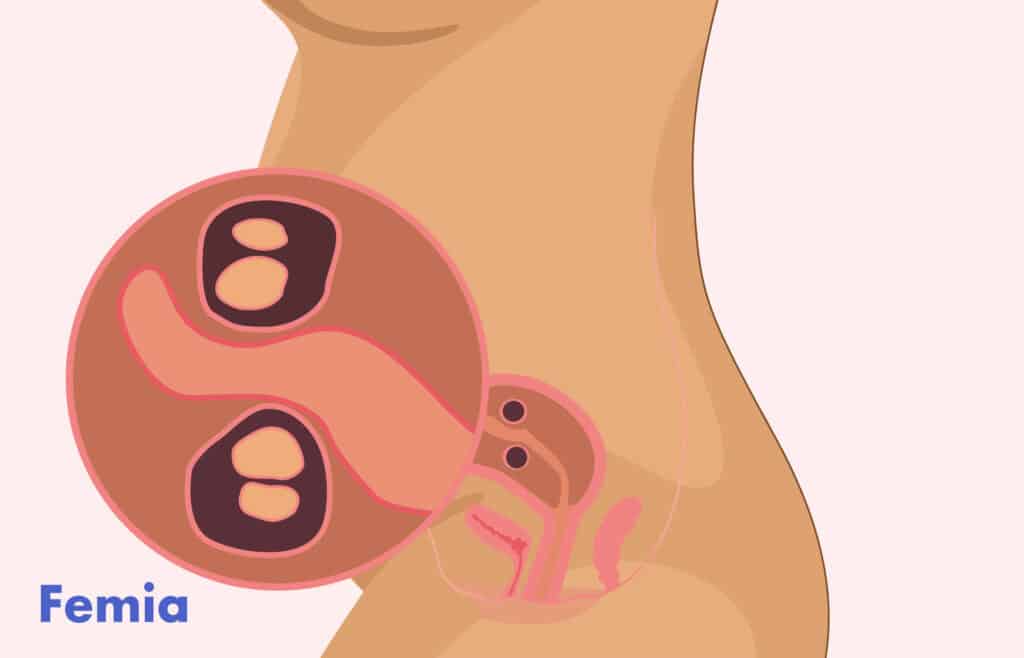
Weeks 9–12 twin pregnancy
During the final month of your first trimester, you will typically be going through the following milestones:
- Your babies’ fingers, toes, and nails will start to shape.
- Facial features will start forming more in detail, showing more developed eyes, nose, upper lip, and profile.
- The babies’ tooth buds will form under the gums.
- Muscles, white blood cells, and vocal cords start shaping.
- Your future babies may start moving, though you may not feel it yet.
- Your baby bump may become a little more pronounced, with your clothes getting a little tight, but, typically, it still won’t be as noticeable on the outside.
By the end of the first trimester, your embryos will grow from only 0.25 inches to about 3 inches long and reach the size of plums.
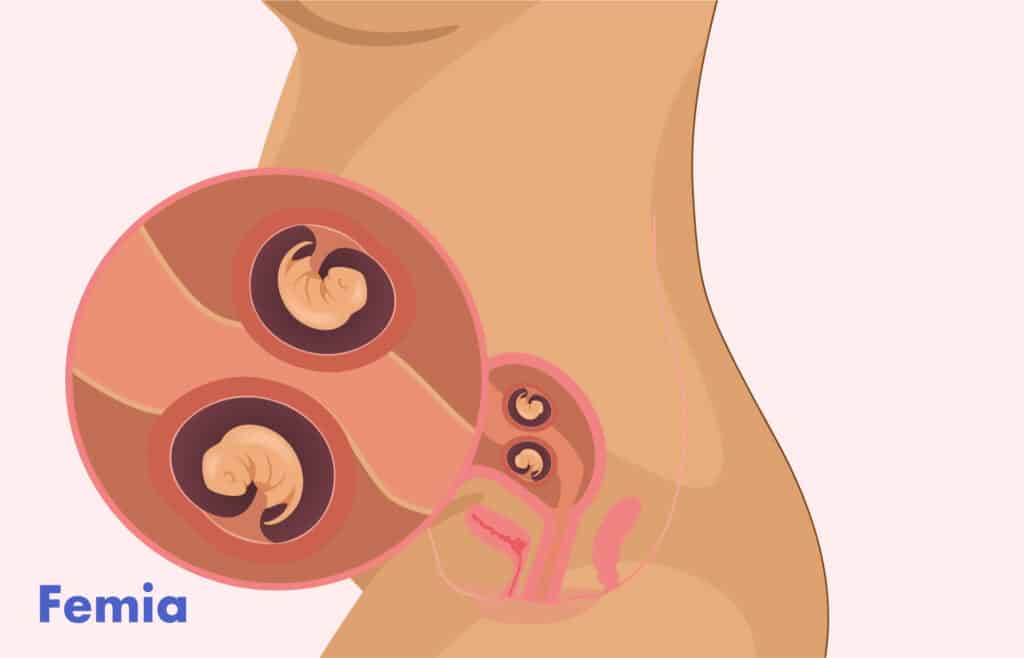
Twin pregnancy: Second trimester (weeks 13–26)
Weeks 13–16 pregnant with twins
The first milestone of the second trimester is when you can see a more noticeable twin pregnancy belly, as your uterus expands more to accommodate the growing babies.
During weeks 13–16, the development of fetuses gets very active:
- The head begins to grow proportionately to the body.
- The babies’ skin starts to thicken, and hair starts growing.
- Some of the babies’ organs (i.e. ears) start taking their permanent locations, lungs start developing, and babies begin to make purposeful movements.
- Their ears will become developed enough to hear you.
- Despite still having closed eyelids, the babies can start reacting to light and turning away.
👉Find out more: 10 weird pregnancy symptoms you didn’t know existed
By the end of week 16, the babies grow to about 5 inches long—the size of an avocado.

Weeks 17–20 twin pregnancy
Weeks 17–20 mark a mid-pregnancy growth. This is the time when many women start showing a prominent baby bump.
The babies’ development during this stage goes through the following key milestones:
- Fetuses start to put on fat.
- Their skin is still thin but is covered with a protective whitish coating (vernix) to prevent excessive skin exposure to amniotic fluid.
- Babies may develop a sleep-wake cycle.
By week 20, the length of fetuses reaches 9–10 inches, their weight may be around a pound, and they are the size of a banana.

Weeks 21–26 twins in the womb
During the last stage of the second trimester, the fetuses grow rapidly and gain weight. They already have eyelashes and can blink. Their lungs are fully developed, and the amniotic fluid begins to diminish.
Due to a growing amount of reserved body fat in the fetuses, you will likely notice fast and significant growth of your baby bump.
During this time, the fetuses also gain strength and start responding to various stimuli (e.g. sounds, light, etc.) more actively by changing their positions, which is why many women begin to feel their movement and kicks.
By the end of week 26, your babies will grow to the size of a scallion.
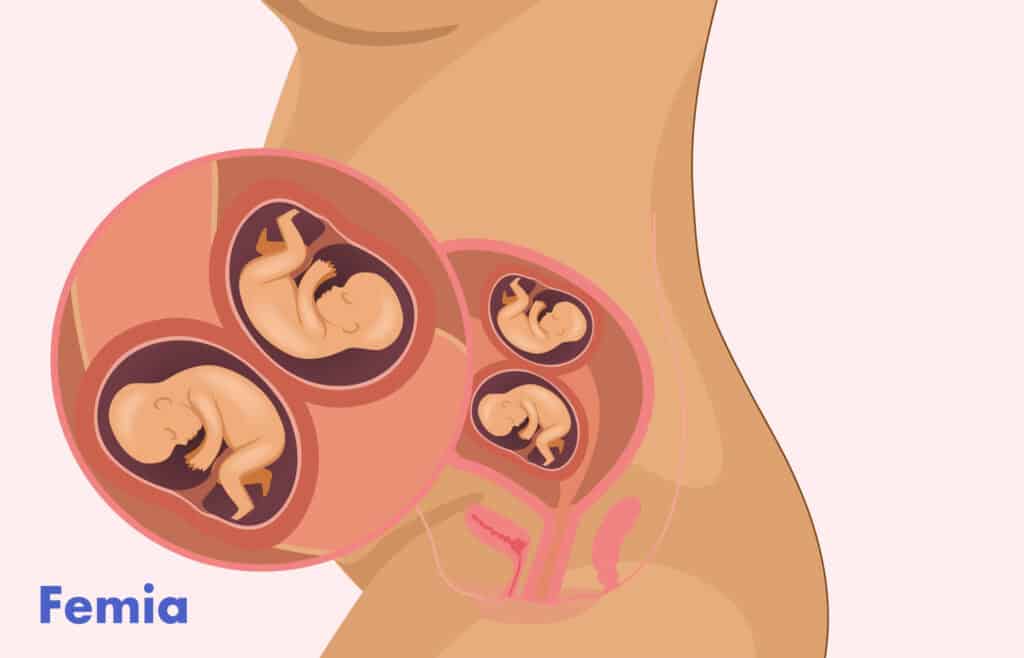
Twin pregnancy: Third trimester (weeks 27–40)
Weeks 27–30 pregnant with twins
The beginning of the third trimester is when you enter the home stretch of your pregnancy. Through weeks 27–30, the fetuses continue their rapid growth. They continue developing body fat, start hearing and seeing most external stimuli, and their kicks may start feeling more like pokes as they start getting cramped in the amniotic sac. The babies’ brains start maturing especially rapidly during this stage.
Due to the growing size and increasing weights of babies, your belly will be getting more prominent and firm. By the end of the 30th week, each of your babies can be 15–16 inches long and weigh up to five pounds. They reach the size of a cucumber.
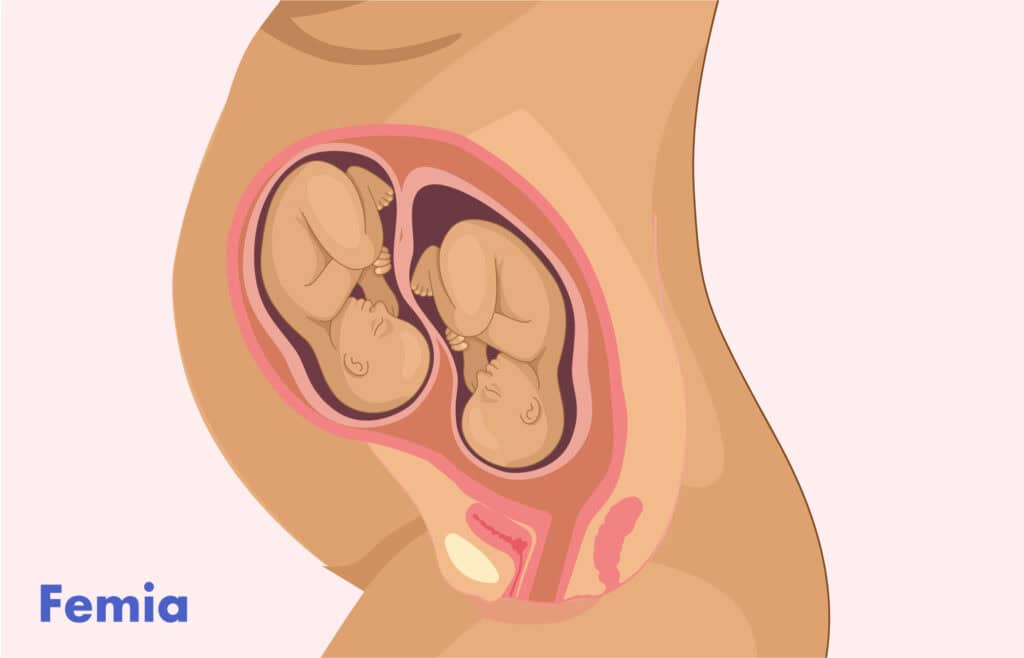
Weeks 31–34 twin pregnancy
Weeks 31–34 mark the final preparations before delivery. Your babies still continue to develop:
- Their bones get harder.
- The musculoskeletal system gets complete.
- The circulatory system becomes fully developed.
- The brain and nervous system get complete.
As the fetuses reach the final stages of their development, they still continue adding fat, nearly reaching their final sizes.
By week 34, the size of each twin is about the size of a pineapple.

Weeks 35–40 twins in the womb
As you enter the final stage of your third trimester, you are getting fully ready for childbirth. During this time, your babies attain their maximum growth and maturity:
- They start losing their protective layers, such as lanugo.
- Their toenails complete their growth.
- The fetuses may start dropping into your pelvis, preparing for labor.
During this time, your babies will be adding up about 0.5 pounds every week to reach their final size. Your belly will reach its maximum size, and you may experience certain discomfort caused by the large size and weight of your babies.
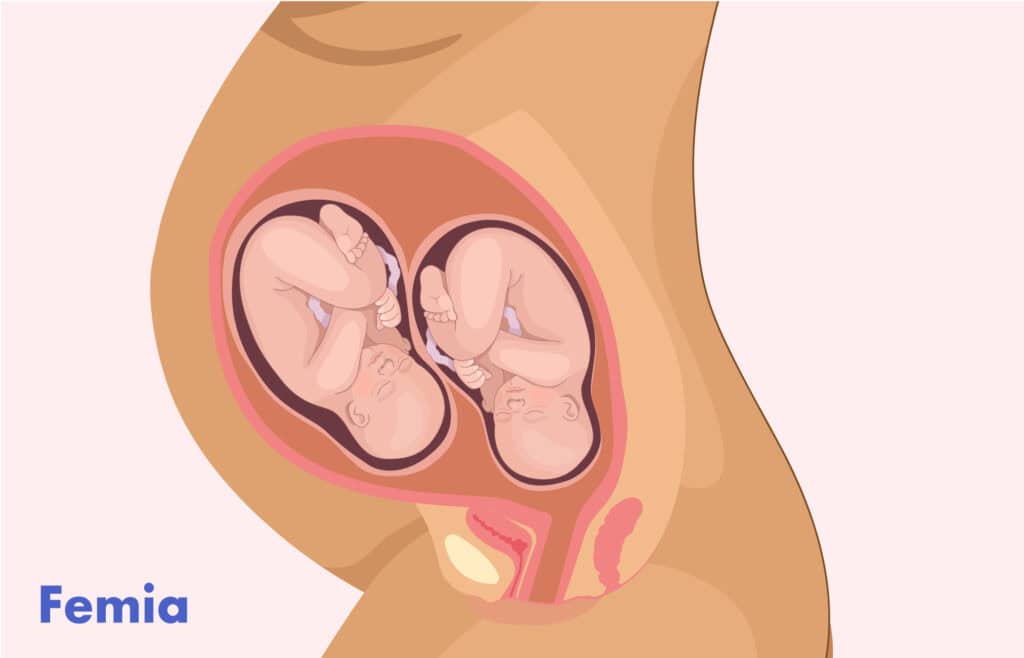
When you get to your due date week (40), your twins should be around 18–20 inches long and 7–9 pounds in weight—the size of a watermelon, each.
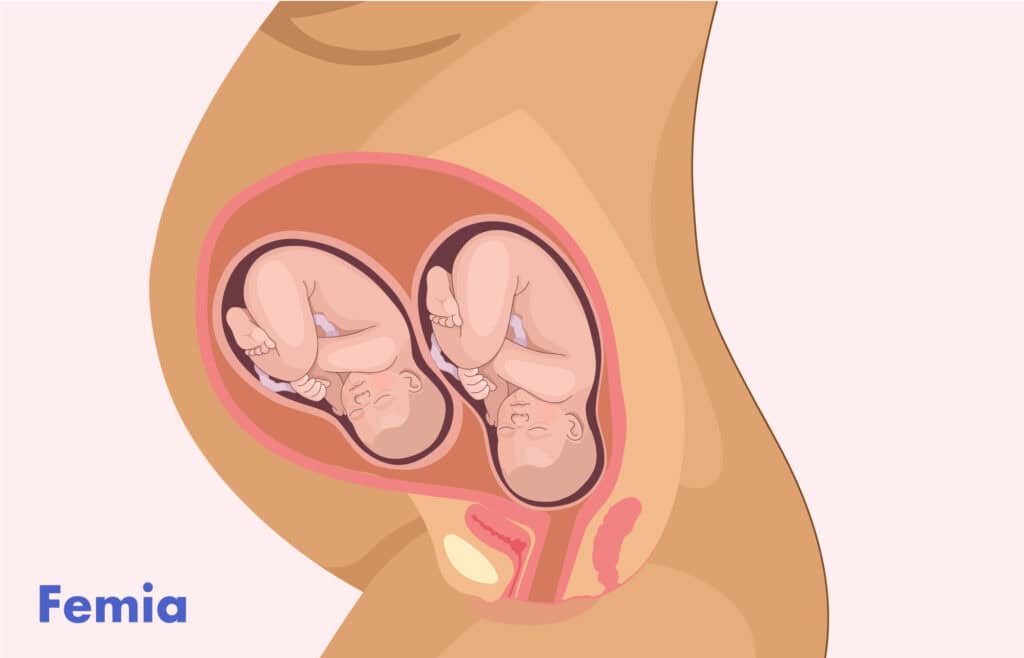
Factors influencing belly size in twin pregnancy
Now that you have a complete overview of changes in a pregnant with twins belly size, we should acknowledge that not all pregnancies will be the same. Some women might have larger or smaller baby bumps due to the following factors:
- Genetics. Maternal genetics are strongly associated with the size of fetuses. The mother’s femoral length affects the fetal height, while weight and lean mass are affected by abdominal circumference. Hence, different body structures and frames can affect the way your belly will look. For example, taller women’s bumps may look smaller, because their uterus has more space to develop upwards instead of outwards.
- Maternal health. Certain health conditions in a mother can affect fetal growth and belly size. For example, diabetes is among the most common reasons for larger baby sizes. The look of your bump might also be impacted by the weight you had before pregnancy as well as the amount of weight you gained during it—in other words, women with more body fat (which supports babies’ growth) may have larger bellies.
- Amniotic fluid levels. Amniotic fluid surrounds the fetus and protects it. If there is a large amount, it may make your bump appear larger, and vice versa.
- Baby positioning. The presentation of babies in the womb may also have a large effect. For example, vertex and breech positions can make your belly look taller, but if you have your twins in the womb, week by week, growing in the transverse lie presentation, your bump might look wider instead.
Managing and embracing belly changes
To create a smooth pregnancy experience, you might want to find ways to embrace the changes that happen to you and manage different manifestations to retain the best comfort, health, and wellbeing.
To create more comfort while your belly is growing, you can try using supporting belly bands, which can help reduce discomfort by giving your abdomen and lower back additional support. Supportive maternity clothes can also help you maintain good posture, minimizing potential back, neck, and leg pain.
The rapid belly growth that takes place during pregnancy is linked to skin changes in some women, often with the appearance of stretch marks. To prevent these effects, follow common skincare routine rules. Stretch mark prevention typically requires lots of nourishment. Researchers suggest using nourishing skincare products with Centella or hyaluronic acid.
Maintaining reasonable physical activity might also be a good way to embrace changes and retain optimal health. Experts recommend regular safe activities throughout pregnancy, but only if there are no specific obstetric or medical contraindications.
Some women show a sharp decrease in self-esteem during pregnancy and right after delivery. Also, many pregnant women may experience drastic mood swings and stresses during their trimesters, which can affect their overall well-being. To prevent this and maintain your mental wellbeing, it might be a good idea to seek support from your family, friends, and healthcare providers.
Questions from the Femia community
When will my belly start to show with twins?
Twin pregnancies are frequently linked to more rapid growth of the uterus, as it needs to accommodate two fetuses instead of one. This may cause some women to start showing a prominent baby bump earlier—around the end of the first trimester or the start of the second one.
How much weight should I expect to gain during a twin pregnancy?
The specific amount of pregnancy weight gain depends on factors like your pre-pregnancy weight and body mass index (BMI). With a normal BMI at the moment of conception, you can expect to gain between 37 and 54 pounds. For underweight or overweight pre-pregnancy bodies, it might be recommended to gain more or less weight accordingly. To monitor your weight gain and ensure a healthy pregnancy, it is important to have regular checkups with your healthcare provider.
What should I do if I notice any unusual symptoms?
Unusual symptoms during pregnancy might involve:
• Persistent headaches
• Heavy bleeding
• Vision changes
• Severe abdominal pain
• Sudden swelling
• And othersIf you experience any of these or other disturbing symptoms, it’s important to get in touch with a doctor right away, as these could signal complications. Prompt professional support can help you ensure you and your babies remain healthy and manage possible complications.
Will my belly size affect my ability to carry my twins to full term?
No, your baby bump size is not a direct factor influencing your ability to carry to full term. Ongoing prenatal care is crucial for keeping track of the mother’s and babies’ health and addressing possible issues timely and efficiently.
The bottom line
Twin pregnancy is an exciting experience that not too many women get to have. This might be one of the reasons why many females who carry twins have questions regarding the physical changes they are going to experience.
From this guide, you now know the twin pregnancy belly week by week size, as well as the primary development milestones that will occur in your babies. A general fetal growth pattern typically applies to twin pregnancies as well. Still, there are some individual factors that can make every woman’s experience different.
To make your own journey smooth, consider consulting your healthcare specialist. They will be able to provide you with personalized care and advice.
References
- Michalopoulos S, Tsikouras P, Varlami V, Lambrinos D, Bothou A, Nikolettos K, Papanikolopoulou S, Marinos G, Iatrakis G, Nikolettos N. “Retrospective Study of the Correlation Between Twin Pregnancies and Perinatal Outcome in Association to the Impact of Preterm Birth.” Mater Sociomed, Sept. 2023. https://www.ncbi.nlm.nih.gov/pmc/articles/PMC10545924/.
- “Signs and symptoms of pregnancy.” The National Health Service (NHS). https://www.nhs.uk/pregnancy/trying-for-a-baby/signs-and-symptoms-of-pregnancy/.
- “Changes During Pregnancy.” The American College of Obstetricians and Gynecologists (ACOG). https://www.acog.org/womens-health/infographics/changes-during-pregnancy.
- Chen HJ, Hsiao SM, Yang CF, Lee CN, Wang YW, Guo DW, Chang SR. “Overactive Bladder during Pregnancy: A Prospective Longitudinal Study.” Medicina (Kaunas), 6, Feb. 2022. https://www.ncbi.nlm.nih.gov/pmc/articles/PMC8875611/.
- “Quickening in Pregnancy.” Cleveland Clinic. https://my.clevelandclinic.org/health/symptoms/22829-quickening-in-pregnancy.
- “Fetal Development.” Cleveland Clinic. https://my.clevelandclinic.org/health/articles/7247-fetal-development-stages-of-growth.
- “Your third trimester guide.” UNICEF Parenting. https://www.unicef.org/parenting/pregnancy-milestones/third-trimester.
- Thame M, Osmond C, Trotman H. “Fetal growth and birth size is associated with maternal anthropometry and body composition.” Matern Child Nutr, Oct. 2015. https://www.ncbi.nlm.nih.gov/pmc/articles/PMC6860297/.
- “Large for Gestational Age.” University of Rochester Medical Center, Health Encyclopedia. https://www.urmc.rochester.edu/encyclopedia/content.aspx?ContentTypeID=90&ContentID=P02383#:~:text=Diabetes%20is%20the%20most%20common,provider%20may%20recommend%20early%20delivery.
- Chasen ST, Spiro SJ, Kalish RB, Chervenak FA. “Changes in fetal presentation in twin pregnancies.” J Matern Fetal Neonatal Med, Jan. 2005. https://pubmed.ncbi.nlm.nih.gov/15804786/.
- “STRETCH MARKS: WHY THEY APPEAR AND HOW TO GET RID OF THEM.” American Academy of Dermatology Association (AAD). https://www.aad.org/public/cosmetic/scars-stretch-marks/stretch-marks-why-appear.
- “Physical Activity and Exercise During Pregnancy and the Postpartum Period.” ACOG Committee Opinion, Number 804. Obstet Gynecol, Apr. 2020. https://pubmed.ncbi.nlm.nih.gov/32217980/.
- Raudasoja M, Vehviläinen-Julkunen K, Tolvanen A. “Passing the test of motherhood? Self-esteem development and birth experience in the transition to motherhood: A longitudinal mixed methods study in Finland.” J Adv Nurs, Dec. 2022. https://www.ncbi.nlm.nih.gov/pmc/articles/PMC9828506/.

Learn how to get short-term disability approved while pregnant, including tips for consulting with your doctor, gathering necessary documentation, and filing a claim.
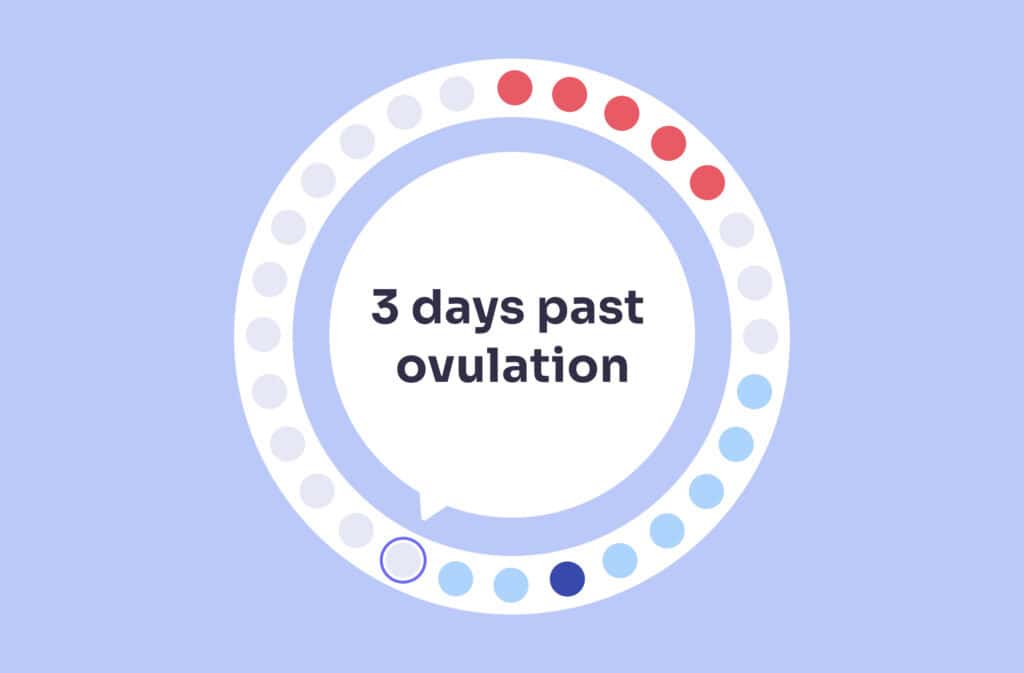
Explore potential symptoms at 3 days past ovulation (3 DPO) and learn what changes might occur. Discover why testing at this stage might not be accurate yet. Expert advice from Femia.

Learn how to perform reverse Kegels to effectively relax your pelvic floor muscles: Step-by-step techniques, benefits, and tips for these exercises for pelvic health.

